
current / archive / issues / faq / RSS feed / twitter /
Blog Archive: August 2018
The Power And The Pride!The previous issue began with a splash page of the Fantastic Four standing around explaining the plot to each other, and exactly the same thing happens at the start of this one. Everyone looks heroic, and I guess it gets the recap out of the way (rather than having it woven through the first few pages as was more usual), but it's a jarringly old-fashioned moment in what goes on to be a thrilling comic.
As the FF explain to each other, their powers are back but they're still trapped in Latveria, so they're making their way to the castle via the medium of chucking lumps of other buildings around as they go. Meanwhile, inside the castle, artist who Doom captured to paint his portrait suggests to the lackey Hauptmann that they should use all this confusion as an opportunity to escape. Hauptmann is having none of it and reveals that he is an ex-Nazi who transferred his allegiance to Doom when the Third Reich collapsed.
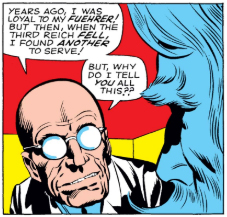 This confirms what I've suspected in previous issues, and solidifies the connection between Doom (and by extension the Eastern Bloc regimes he represents) and Fascism. This link will be swiftly peddled back when Doom gets his own series, and it sticks out here as an uncomfortable oddity in his long-term character progression. Doom doesn't think one race is better than any other, he just thinks he's better than everyone!
This confirms what I've suspected in previous issues, and solidifies the connection between Doom (and by extension the Eastern Bloc regimes he represents) and Fascism. This link will be swiftly peddled back when Doom gets his own series, and it sticks out here as an uncomfortable oddity in his long-term character progression. Doom doesn't think one race is better than any other, he just thinks he's better than everyone!
Hauptmann takes the news to Doom who, quite understandably, points out that he's very much aware of his arch enemies lobbing chunks of churches at his home. He explains that he has (yet another) cunning plan to deal with them - Hyper Sound!
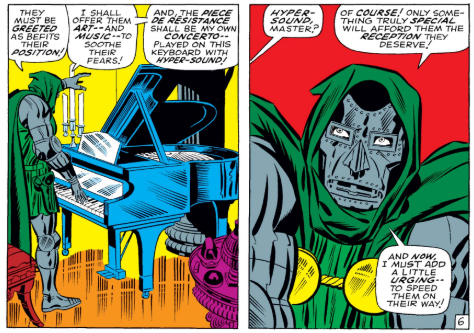 Rather than finding out what this actually means we're instead shown the progress of the Fantastic Four as they make their way into the castle. What usually seems to happen at this point is that The Invisible Girl somehow gets kidnapped, but this time both her AND her maternity cover, Crystal, fall into a trap, leaving the men to fight some Doombots. At least, I think they're Doombots - they have purple skin and robotic clothing, and I'm pretty sure they behaved like Doombots in earlier issues, but now they seem to be human beings in electronic uniforms. I wonder if this was a bit of confusion between Lee and Kirby?
Rather than finding out what this actually means we're instead shown the progress of the Fantastic Four as they make their way into the castle. What usually seems to happen at this point is that The Invisible Girl somehow gets kidnapped, but this time both her AND her maternity cover, Crystal, fall into a trap, leaving the men to fight some Doombots. At least, I think they're Doombots - they have purple skin and robotic clothing, and I'm pretty sure they behaved like Doombots in earlier issues, but now they seem to be human beings in electronic uniforms. I wonder if this was a bit of confusion between Lee and Kirby?
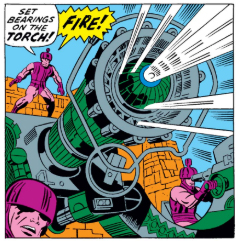 Whatever they are, Sue and Crystal fight even more of them when they land in an underground bunker, fighting through until they burst in on... Doctor Doom and a slap-up feast!
Whatever they are, Sue and Crystal fight even more of them when they land in an underground bunker, fighting through until they burst in on... Doctor Doom and a slap-up feast!
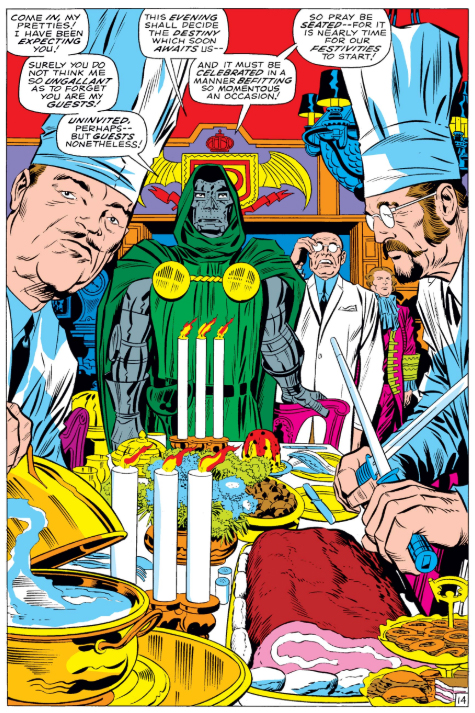 Doom plays the perfect host, indulging in small-talk about Sue's recently arrived baby. As usual, he's claiming to be a gentleman, treating the women as guests and providing them with food, drink, and also culture, in the form of a recital on the piano. We get the first inkling that there might be something more to this than meets the eye when we see that he has yet another viewing screening set into the piano, which he uses to keep an eye on the rest of the Fantastic Four.
Doom plays the perfect host, indulging in small-talk about Sue's recently arrived baby. As usual, he's claiming to be a gentleman, treating the women as guests and providing them with food, drink, and also culture, in the form of a recital on the piano. We get the first inkling that there might be something more to this than meets the eye when we see that he has yet another viewing screening set into the piano, which he uses to keep an eye on the rest of the Fantastic Four.
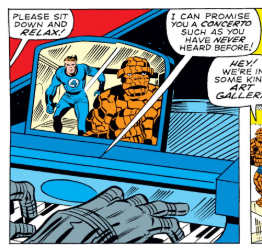 The men uncover a room full of priceless art, stolen by Doom. However, before they can browse the catalogue Hauptmann bursts in with a flame thrower, determined to win his master's approval by murdering his arch enemies. What he doesn't reckon with is Doom's apparently genuine love of Art - he cannot bear to see his collection destroyed, and so is forced to use his Hyper Sound piano to kill his aide before he can burn down the gallery.
The men uncover a room full of priceless art, stolen by Doom. However, before they can browse the catalogue Hauptmann bursts in with a flame thrower, determined to win his master's approval by murdering his arch enemies. What he doesn't reckon with is Doom's apparently genuine love of Art - he cannot bear to see his collection destroyed, and so is forced to use his Hyper Sound piano to kill his aide before he can burn down the gallery.
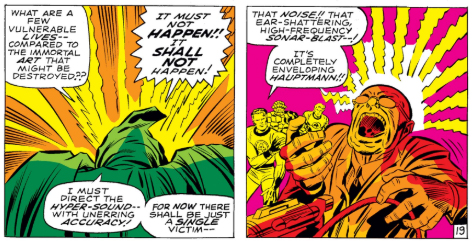 This is another example of Doom's strange code of honour. He claims to be a man of taste and education, who appreciates great art so much that he's not only prepared to kill his aide to preserve it, but also to ruin his own carefully laid plans to do so. By blasting the Hyper Sound Piano at Hauptmann he has, apparently, used it all up, so there is no way of killing the Fantastic Four any more. Thus he sets them free, in the pre-advertised "Possibly the most off-beat ending of the year!"
This is another example of Doom's strange code of honour. He claims to be a man of taste and education, who appreciates great art so much that he's not only prepared to kill his aide to preserve it, but also to ruin his own carefully laid plans to do so. By blasting the Hyper Sound Piano at Hauptmann he has, apparently, used it all up, so there is no way of killing the Fantastic Four any more. Thus he sets them free, in the pre-advertised "Possibly the most off-beat ending of the year!"
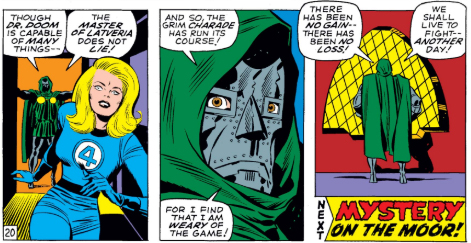 So ends what would be Lee and Kirby's final Doctor Doom story - and what a way to go out, throwing all the excitement available into the mix but also developing one of their greatest characters even further. The Doctor Doom who was happy to work alone and then chuck himself out of a window when it all goes wrong is now long gone. This revised version of Doom is all-powerful, ensconced in his own world, and even more contradictory and deluded than ever. "The Master of Latveria does not lie", he says, which is a great big fib as well he knows! He's become one of Marvel's greatest, most complex characters, fully deserving of a series of his own - as we shall soon see!
So ends what would be Lee and Kirby's final Doctor Doom story - and what a way to go out, throwing all the excitement available into the mix but also developing one of their greatest characters even further. The Doctor Doom who was happy to work alone and then chuck himself out of a window when it all goes wrong is now long gone. This revised version of Doom is all-powerful, ensconced in his own world, and even more contradictory and deluded than ever. "The Master of Latveria does not lie", he says, which is a great big fib as well he knows! He's become one of Marvel's greatest, most complex characters, fully deserving of a series of his own - as we shall soon see!
posted 29/8/2018 by MJ Hibbett
(click here for permanent link)
(0) comments
This Man! This Demon!
We take a break from our ongoing story for something very different, but vital to Doom's development, in Marvel Super-Heroes #20.
The title "Marvel Super-Heroes" first appeared as the name of a terrible cartoon series in 1966 (which I have moaned about previously) with an accommpanying one-off "Marvel Super-Heroes" comic to go with it. The series which this issue is part of, however, was originally called "Fantasy Masterpieces" and was dedicated to reprints of Golden Age stories. It continued to feature these when the name was changed to "Marvel Super-Heroes" with issue 12, when a "try-out" feature was added as the lead story. The experiment with try-outs had some success, showcasing the first appearances of Marvel's own version of Captain Marvel, The Guardians of The Galaxy and the revived Ka-Zar, although after this issue it would return to all reprints again.
These stories went down well enough for Doom and Ka-Zar to go on to share lead roles in "Astonishing Tales", and you can see why, with Doom at least. This is a really enjoyable character study which adds greater depth to Doom's personality, although it does grate a little when read alongside the story being published simultaneously in "The Fantastic Four". This version of Doom is much more in line with how he's been previously portrayed, as a vain, tortured man who believes he's doing the right thing, rather than the deluded dictator he's transforming into elsewhere.
The story has been very rarely reprinted, appearing as part of "Giant Size Super-Villain Team-Up" a few years later and then in the collected "Essentials" version of the same, but that's about it. It seems odd, as it's a great piece that has lasting repercussions for the way the character would be portrayed.
It all kicks off with Doom reliving some of his past defeats by The Fantastic Four, in an effort to learn what went wrong. I'm all in favour of some personal growth, but right away this differs from the current portrayal of a Doom who doesn't believe he ever is wrong. Here he's quite clear about how many humiliations he's previously faced.
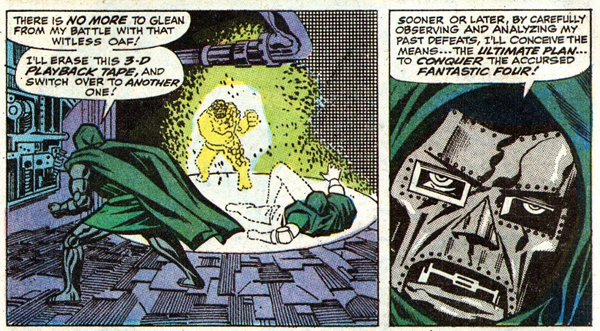 His revision is interrupted when the characters from the "3D Playback Tape" come to life and fight him. Doom does pretty well fighting the illusory Fantastic Four (which at least shows that his studies have been worthwhile) until they fade away, and Diabol reveals himself as being behind the attack.
His revision is interrupted when the characters from the "3D Playback Tape" come to life and fight him. Doom does pretty well fighting the illusory Fantastic Four (which at least shows that his studies have been worthwhile) until they fade away, and Diabol reveals himself as being behind the attack.
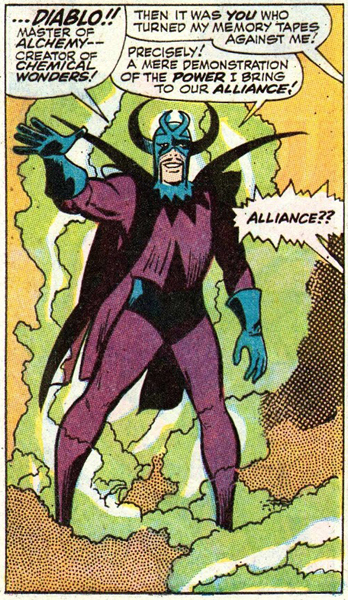 Diablo is there to propose an Alliance, which Doom refuses and, as is the rule for meetings of Supervillains (and most meetings of Superheroes too) they immediately get into a fight. This ends in a stalemate as Doom's science cannot beat Diablo's ... er... Chemistry, so the latter reveals that he has another means of persuading Doom to join him - a hostage!
Diablo is there to propose an Alliance, which Doom refuses and, as is the rule for meetings of Supervillains (and most meetings of Superheroes too) they immediately get into a fight. This ends in a stalemate as Doom's science cannot beat Diablo's ... er... Chemistry, so the latter reveals that he has another means of persuading Doom to join him - a hostage!
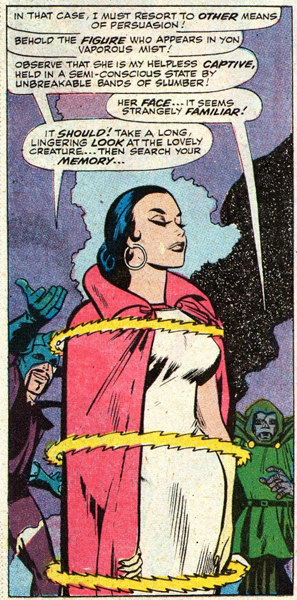 This is a neat turnaround, as it's usually Doom who goes around kidnapping people. The sight leads Doom into a recap of his origin story, this time with another character added, a "childhood friend" who is inserted into a fairly straight retelling of the story, complete with precise reconstructions of a lot of the imagery.
This is a neat turnaround, as it's usually Doom who goes around kidnapping people. The sight leads Doom into a recap of his origin story, this time with another character added, a "childhood friend" who is inserted into a fairly straight retelling of the story, complete with precise reconstructions of a lot of the imagery.
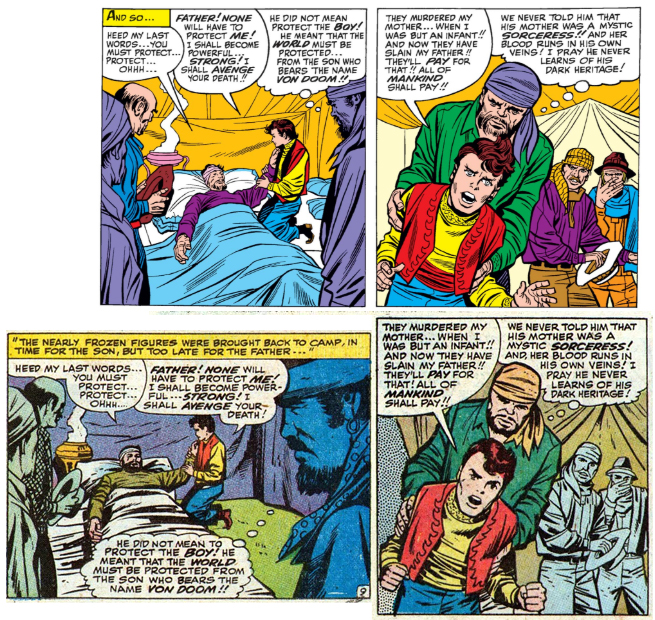 In a very neat bit of retconning the as yet unnamed girl is skilfully slotted in between the frames. The script is co-credited to Larry Lieber and Roy Thomas, with Lieber apparently doing the first half up to page 11, but this does feel a lot like the kind of retelling of history that Roy Thomas would later take much delight in, in series like "The Invaders".
In a very neat bit of retconning the as yet unnamed girl is skilfully slotted in between the frames. The script is co-credited to Larry Lieber and Roy Thomas, with Lieber apparently doing the first half up to page 11, but this does feel a lot like the kind of retelling of history that Roy Thomas would later take much delight in, in series like "The Invaders".
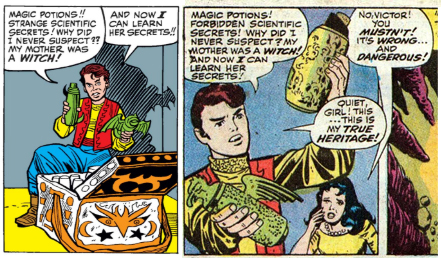 Valeria (as she's finally named on page 10) begs the young Victor to stay in Latveria, but he's determined to to go to America to learn as much as he can about science, as part of his bid for power - the only thing he cares about now. "I have no love... no compassion, not a tender feeling to share with anyone," he tells her, leaving Valeria to mourn the man he once was.
Valeria (as she's finally named on page 10) begs the young Victor to stay in Latveria, but he's determined to to go to America to learn as much as he can about science, as part of his bid for power - the only thing he cares about now. "I have no love... no compassion, not a tender feeling to share with anyone," he tells her, leaving Valeria to mourn the man he once was.
It's all a bit "Ghost Of Christmas Past" really, and once Doom returns to the present day Diablo even tells him that he'll be visited again shortly, though admittedly just by Diablo returning to see if he'll change his mind about teaming up.
The first half of the story then ends with Doom pondering the fact that seeing Valeria has had an unexpected emotional effect upon him.
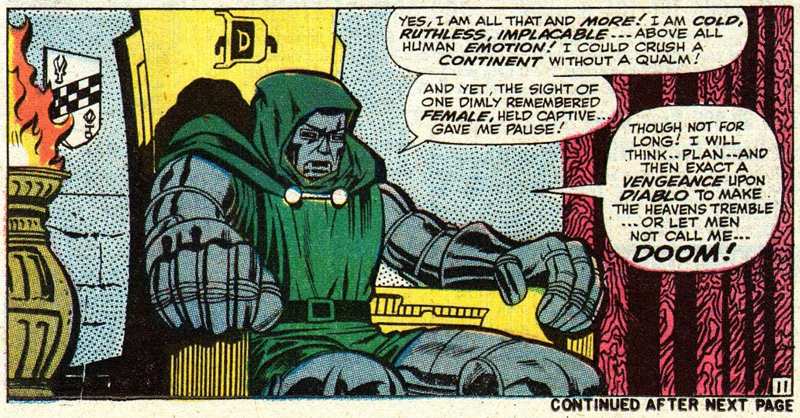 This feels very much like a deliberate end of a "chapter", and the fact that the following page is a splash, recapping what's happened so far, leads me to wander whether this was originally intended to be a two parter? Each part is the same length as Doom's half of "Astonishing Tales" would be, and it make senses of Lieber stopping halfway through and Roy Thomas taking over, so I wonder if this was meant to be the start of that series, but put into "Marvel Super-Heroes" instead? Don't ask me, I don't know!
This feels very much like a deliberate end of a "chapter", and the fact that the following page is a splash, recapping what's happened so far, leads me to wander whether this was originally intended to be a two parter? Each part is the same length as Doom's half of "Astonishing Tales" would be, and it make senses of Lieber stopping halfway through and Roy Thomas taking over, so I wonder if this was meant to be the start of that series, but put into "Marvel Super-Heroes" instead? Don't ask me, I don't know!
The second half begins with more of the self-pity Doom would regularly exhibit during his early years, in a panel which seems to be specifically drawn to recall those stories.
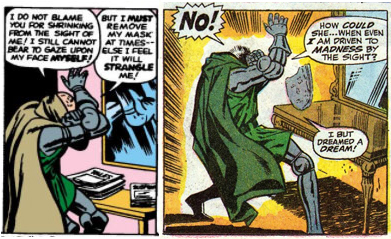 Again, this is very different from the current version of Doom who, only a couple of months ago was not only able to look at himself in a mirror, but was ready to force others to do the same too.
Again, this is very different from the current version of Doom who, only a couple of months ago was not only able to look at himself in a mirror, but was ready to force others to do the same too.
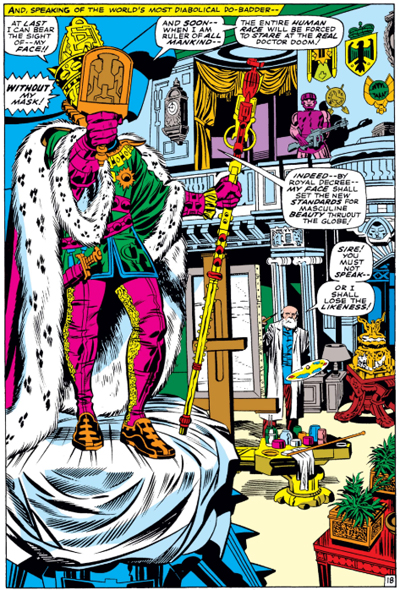 The Grand Comics Database suggests that this story comes before Fantastic Four #84 in continuity, but there's nothing in the text to suggest that it does. Perhaps the Doom currently appearing in The Fantastic Four is just having one of those days where you act like a bit of a dick?
The Grand Comics Database suggests that this story comes before Fantastic Four #84 in continuity, but there's nothing in the text to suggest that it does. Perhaps the Doom currently appearing in The Fantastic Four is just having one of those days where you act like a bit of a dick?
He's definitely in full-on Emo mode here though, eventually consoling himself with the idea that he shouldn't get all upset about his physical appearance when he is who he is - Doom! Positive self-image! You go Victor!
Diablo returns to taunt Doom with images of Valeria, which leads to him taking decisive action and flying off to America, where he finds that - finally - the government has decided that it might be a good idea to maybe put some guards around his old castle/headquarters, rather than letting just anybody wander in as has previously been the case.
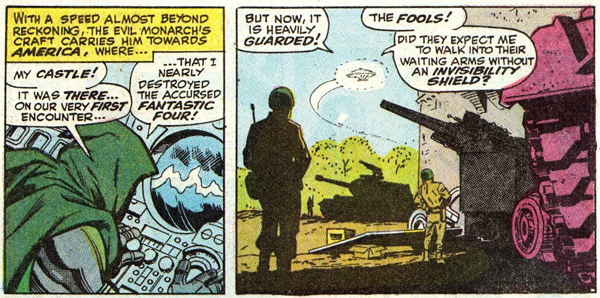 Once past the ineffectual guards he discovers Diablo holding Valeria hostage. How Diablo got in, or how Doom knew he'd be there, are not explained, but then we don't ever find out how Valeira was kidnapped either, or where she's been all this time. Instead Doom decides to destroy the guards surrounding his castle, because he's the kind of guy who likes to take direct action rather than hiding behind politics.
Once past the ineffectual guards he discovers Diablo holding Valeria hostage. How Diablo got in, or how Doom knew he'd be there, are not explained, but then we don't ever find out how Valeira was kidnapped either, or where she's been all this time. Instead Doom decides to destroy the guards surrounding his castle, because he's the kind of guy who likes to take direct action rather than hiding behind politics.
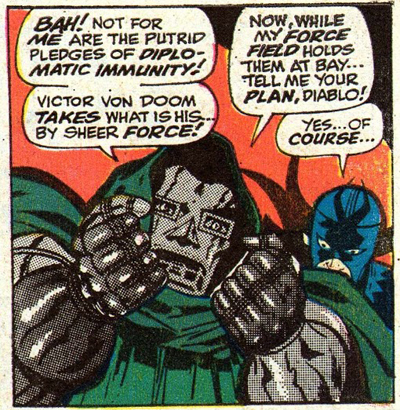 Um... I beg your pardon? Isn't this the same Doctor Doom who has regularly used diplomatic immunity as a key part of his plans and actions? This level of contradiction makes me wonder if Roy Thomas is trying to say something about how the character has changed from his original personality, losing his dynamism to become a statesman instead. It certainly bares little resemblance to the character appearing elsewhere!
Um... I beg your pardon? Isn't this the same Doctor Doom who has regularly used diplomatic immunity as a key part of his plans and actions? This level of contradiction makes me wonder if Roy Thomas is trying to say something about how the character has changed from his original personality, losing his dynamism to become a statesman instead. It certainly bares little resemblance to the character appearing elsewhere!
Diablo has a cunning scheme to use Doom's time machine to alter the course of history, which Doom listens to patiently - after all, others have listened to enough of his mad rants, so it's only polite that he should do the same. He uses his listening time to get close enough to the Time Machine so he can activate a force field, cutting him and Valeria off from Diablo. Another fight ensues, during which Diablo lures Doom onto the Time Machine and then switches it on, only to find that Doom had earlier changed the settings (he did, we saw him do it!) so that it's the person activating the device, not the person stood on its platform, who gets transported. Diablo thus teleports himself into a nightmarish post-nuclear future where everybody else is dead.
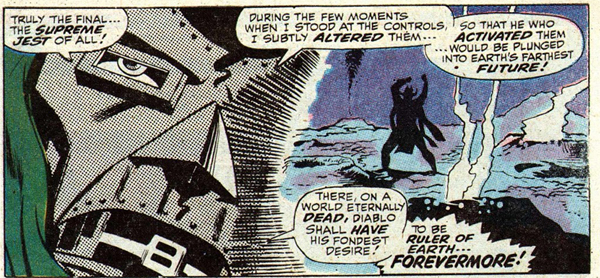 You've got to admit, that's a pretty good trick!
You've got to admit, that's a pretty good trick!
Valeria, however, does not think so. When Doom turns to her, ready to "recapture a lifetime together" she immediately and firmly rejects him.
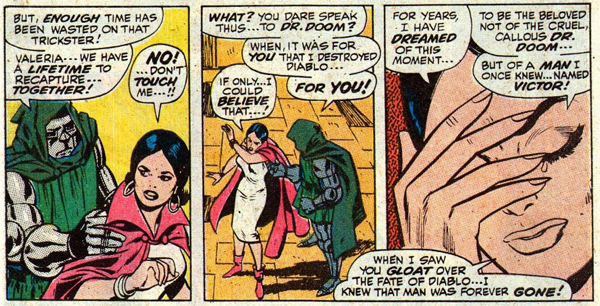 She asks if her appraisal of him is wrong, and he cannot reply, leaving her to walk off.
She asks if her appraisal of him is wrong, and he cannot reply, leaving her to walk off.
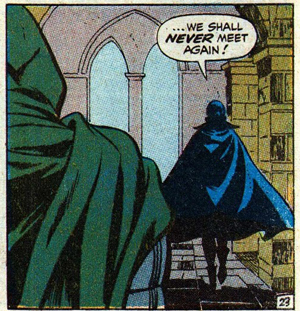
The last page sees Doom alone, in shadow, "knowing, at long last, that it is not his burnt scarred face... his grim metal mask... which are now and forever his merciless prison... but the man himself... the tortured, twisted being whom the world calls only... Doom!!"
Wow! What an ending! What a story! What a great examination of a character which does not entirely line-up with how he was simultaneously portrayed elsewhere!
These two portrayals of Doom will fight it out over the years to come, with one occasionally taking precedence over the other for a period, such as when Doom was all-out evil in Waid & Weiringo's run on "Fantastic Four", only to become tortured and reflective in Brian Bendis's recent "Infamous Iron Man". For now though it's a quick return to the deluded dictator in the conclusion of Lee & Kirby's tribute to "The Prisoner" - next time!
posted 22/8/2018 by MJ Hibbett
(click here for permanent link)
(0) comments
The Victims!
This issue starts right where the last one ended, with the Fantastic Four trapped in a Village in Latveria without their powers, waiting for some Killer Robots to attack. If you didn't already know this you'd be quickly brought up to speed by the team explaining it to each other in the opening splash page - in the modern age of Recap Pages it feels a bit clunky, but once that's out of the way we're into the action, with Reed Richards telling the villagers to go and hide in their homes while the FF try to protect them.
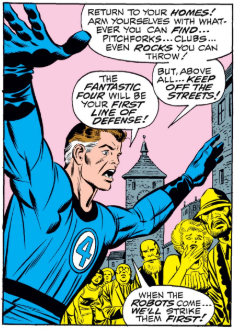 At this point another of Doctor Doom's mobile TV screens arrive, with him expressing his regrets for any inconvenience caused by the accidental unleashing of a horde of killer robots. When Reed Richards questions the sincerity of this non-apology Doctor Doom is utterly horrified that anybody could be so ungrateful in what are trying circumstances for everyone.
At this point another of Doctor Doom's mobile TV screens arrive, with him expressing his regrets for any inconvenience caused by the accidental unleashing of a horde of killer robots. When Reed Richards questions the sincerity of this non-apology Doctor Doom is utterly horrified that anybody could be so ungrateful in what are trying circumstances for everyone.
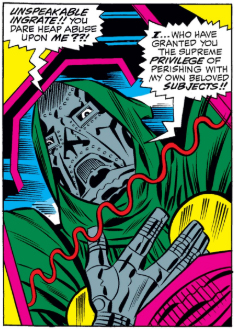 This is all very much in keeping with the new developments in Doom's character, where his delusion has reached such heights that he seems genuinely surprised that anybody would not be grateful for his benevolent, if fatal, leadership. It's also pretty funny!
This is all very much in keeping with the new developments in Doom's character, where his delusion has reached such heights that he seems genuinely surprised that anybody would not be grateful for his benevolent, if fatal, leadership. It's also pretty funny!
Next we see him musing on the fact that his plan has not been entirely flawless. The Killer Robots really have escaped, but cunningly he has installed a secret weakness within them that means that, if they ever turn upon their creator, he will be able to stop them. Ooh, I wonder what it could be? Something very clever, no doubt!
The Robots smash their way through walls and arrive at the village, where the Fantastic Four discover that their powers are gradually returning. The villagers help them fight back, but, as Doctor Doom watches the mayhem from a balcony on his castle, it seems that it will not be enough to save them.
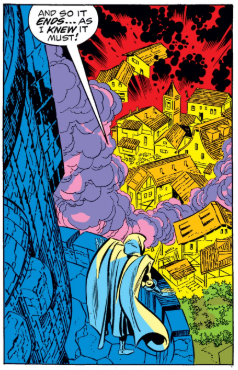 His aide Hauptmann warns Doom not to underestimate the Fantastic Four. Given his employer's track record in dealing with staff suggestions this is a spectacularly brave/foolish move, but luckily for him Doom agrees, and hopes that the team are destroyed before Reed Richards discover the secret flaw in the robots. It's worth noting that the name "Hauptmann" is German for "Captain", a fact that would be familiar to many readers from years of reading war comics. It seems that Stan Lee is once again nudging Doom towards Nazi territory, inferring that Doom's men, if not Doom himsefl, are relics of fascism.
His aide Hauptmann warns Doom not to underestimate the Fantastic Four. Given his employer's track record in dealing with staff suggestions this is a spectacularly brave/foolish move, but luckily for him Doom agrees, and hopes that the team are destroyed before Reed Richards discover the secret flaw in the robots. It's worth noting that the name "Hauptmann" is German for "Captain", a fact that would be familiar to many readers from years of reading war comics. It seems that Stan Lee is once again nudging Doom towards Nazi territory, inferring that Doom's men, if not Doom himsefl, are relics of fascism.
While the battle goes on in the village Doom decides to show Hauptmann his back-up plan, in case the otherwise almost entirely flawless main plan hits any problems. He shows his aide a model of the target village, which they have looked upon many times before. However, with the click of a switch Doom reveals that there is more to the village than meets the eye!
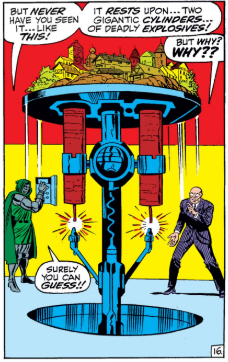 "Why?" says Hauptmann, though "What the HECK is THAT?" might have been more to the point. It appears that the village is built on two GIGANTIC sticks of TNT with skyscraper sized fuses, poised delicately close to similarly gargantuan sparks. In a series full of fantastically ludicrous ideas, this is one of the most fantastically ludicrous, and you've got to admire Kirby's chutzpah in not only thinking he can get away with something as utterly daft as this, but then actually getting away with it!
"Why?" says Hauptmann, though "What the HECK is THAT?" might have been more to the point. It appears that the village is built on two GIGANTIC sticks of TNT with skyscraper sized fuses, poised delicately close to similarly gargantuan sparks. In a series full of fantastically ludicrous ideas, this is one of the most fantastically ludicrous, and you've got to admire Kirby's chutzpah in not only thinking he can get away with something as utterly daft as this, but then actually getting away with it!
Back in the village the FF and the villagers prepare to meet the robots. The only thing they have to defend them is a very vaguely defined "control unit" that can open pits in the ground and throws people into the air. It was hidden in one of the turrets of a bridge... for some reason? Anyway, this sequence is VERY exciting, as we watch the robots getting closer and closer before finally arriving with Mr Fantastic immediately clicking a switch to do... something!
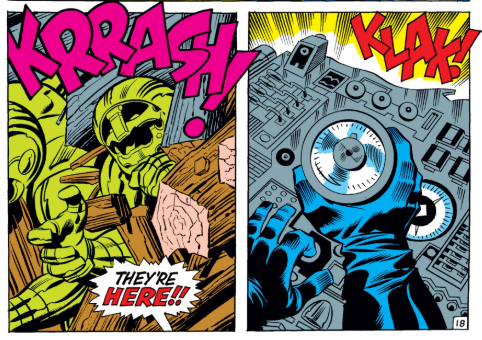 I very rarely talk about the lettering in these comics, but crikey, look at the "Krrash!" and "Klak!" in these two panels - amazing work by Sam Rosen!
I very rarely talk about the lettering in these comics, but crikey, look at the "Krrash!" and "Klak!" in these two panels - amazing work by Sam Rosen!
This time the device triggers a "hidden turbulence pressure engine", which rather handily throws all the robots up into the air and into the river.
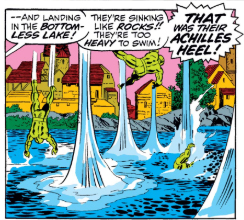 Hang on, the major flaw in the robots was that they were too heavy to swim? That was IT? This sounds very much like Doom trying to make out that a major design flaw is in fact a FEATURE. I wonder if that was Jack Kirby's intent all along, or whether Stan Lee added it in to explain how chucking the robots in a river is enough to defeat them?
Hang on, the major flaw in the robots was that they were too heavy to swim? That was IT? This sounds very much like Doom trying to make out that a major design flaw is in fact a FEATURE. I wonder if that was Jack Kirby's intent all along, or whether Stan Lee added it in to explain how chucking the robots in a river is enough to defeat them?
Doom is utterly incensed, and presses the button to detonate the gigantic sticks of TNT. Hauptmann begs him not to do it - "Think of the people!"
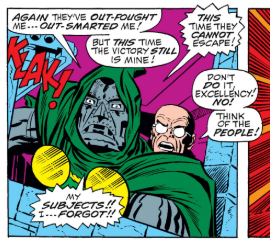 "I... forgot!" says Doom. This is another instance where I wonder if Stan Lee added a line of dialogue to excuse Doom flat out murdering a whole bunch of his subjects. He'd already condemned them to death with his Killer Robots, but maybe he's able to excuse that as an "accident", whereas this is killing them more directly. It's the only time in the whole issue where he does genuinely give a thought to his people - when Latveria was first introduced he seemed to genuinely care about them, but this reminder of such previous behaviour tends to highlight the fact that he's now a heartless, self-fixated dictator.
"I... forgot!" says Doom. This is another instance where I wonder if Stan Lee added a line of dialogue to excuse Doom flat out murdering a whole bunch of his subjects. He'd already condemned them to death with his Killer Robots, but maybe he's able to excuse that as an "accident", whereas this is killing them more directly. It's the only time in the whole issue where he does genuinely give a thought to his people - when Latveria was first introduced he seemed to genuinely care about them, but this reminder of such previous behaviour tends to highlight the fact that he's now a heartless, self-fixated dictator.
The whole town is destroyed, but luckily one small section - the bit where the FF and the townspeople had all gathered - is protected by what appears to be a force field. It was The Invisible Girl! She was so worried that she made Nick Fury tell her where the rest of the team had gone, sorted out a babysitter, and then ... somehow made her way to Latveria, secretly entered the country, discovered where they were, and then snuck over to save them all.
That sounds fair enough.
With the whole team back together at last it's time to go and "tackle Doom", as The Thing says. "Next: The Wrap-up!" says the final panel, but before that we've got another visit to Latveria to fit in, in a very different story indeed!
posted 17/8/2018 by MJ Hibbett
(click here for permanent link)
(0) comments
Brand Ecch No More
This would be the final issue of 'Not Brand Ecch' until it was continued in a special issue 48 years later. It goes out as a confusing mixture of satires on Marvel's own output, mash-ups of other companies' characters, Mad-style film parodies, one-off gags, and a Forbush Man story. It's a sort of summary of the entire run of the comic, and therefore also features several appearances by Doctor Doom.
He's there on the cover, as part of a group of pretend trading stamps.
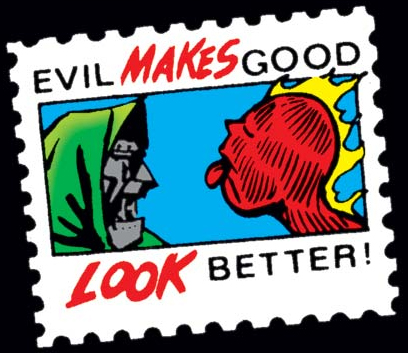 Once again, he's there as a representative of supervillainy. This is a role he's fallen into over the course of this series, being used as an avatar of evil, almost apart from his own character in the main Marvel Universe.
Once again, he's there as a representative of supervillainy. This is a role he's fallen into over the course of this series, being used as an avatar of evil, almost apart from his own character in the main Marvel Universe.
His first appearance within the comic itself, however, does make a small reference to the more usual characteristics of Doom, via some balloons that say "Visit Beautiful Blatveria".
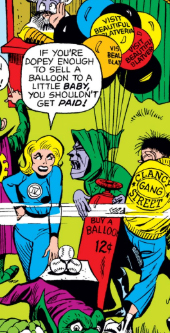 This is a "humorous" reference to the nation of Latveria which has become a much bigger part of Doom's character in recent years, notably in the storyline occurring simultaneously in "The Fantastic Four". The wording on the balloons is just an extra detail, rather than the gag itself, but it does at least refer to an aspect of Doom himself, rather than using him as a symbol.
This is a "humorous" reference to the nation of Latveria which has become a much bigger part of Doom's character in recent years, notably in the storyline occurring simultaneously in "The Fantastic Four". The wording on the balloons is just an extra detail, rather than the gag itself, but it does at least refer to an aspect of Doom himself, rather than using him as a symbol.
Normal service is resumed for his final appearance, as part of a crowd of superheroes, villains, and other company's characters on a Valentine's Card featuring Forbush-Man.
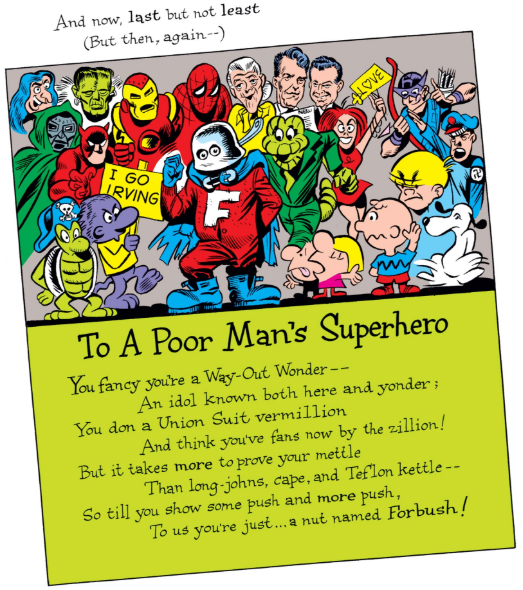 The remarkable thing about all of Doom's appearance over the course of the series is that he has been used almost exclusively as a representation of the wider "Supervillain Community". In most cases another character such as Magneto or Doctor Octopus could have been used without losing any of the humour, but almost invariably it's Doctor Doom that is chosen. This demonstrates how important and how recognisable he is within the Marvel Universe, even at a time when he is almost absent from stories within the main continuity. I've been surprised to find such a rich seam of material in what appeared to be such an obscure, ephemeral series. I can't say I'll miss reading 'Not Brand Ecch', but I'm glad that I did!
The remarkable thing about all of Doom's appearance over the course of the series is that he has been used almost exclusively as a representation of the wider "Supervillain Community". In most cases another character such as Magneto or Doctor Octopus could have been used without losing any of the humour, but almost invariably it's Doctor Doom that is chosen. This demonstrates how important and how recognisable he is within the Marvel Universe, even at a time when he is almost absent from stories within the main continuity. I've been surprised to find such a rich seam of material in what appeared to be such an obscure, ephemeral series. I can't say I'll miss reading 'Not Brand Ecch', but I'm glad that I did!
posted 15/8/2018 by MJ Hibbett
(click here for permanent link)
(0) comments
Prisoners In The Village
This issue continues directly from the one before, with Doctor Doom talking to a captured Fantastic Four through an "electronic spy scope" (or "Skype call" in today's money). This is a distinctly different Doctor Doom from previous encounters. He's always enjoyed taunting his enemies from afar, but here he does it in the guise of kindness, telling them that they will now be looked after under his rule.
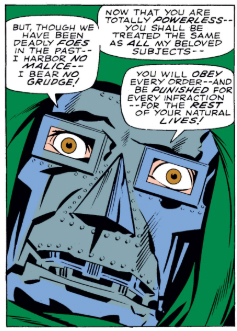 Doom's character has changed, from a wise leader who only undertook villainous activities for the benefit of his people, to a deluded dictator who believes they are foolish children who must be severely punished if they ever stray. It's a view of dictators and their propaganda-based denial of reality that reminds me of the various "Number Twos" in "The Prisoner", and indeed by dictatorships in literature and real-life.
Doom's character has changed, from a wise leader who only undertook villainous activities for the benefit of his people, to a deluded dictator who believes they are foolish children who must be severely punished if they ever stray. It's a view of dictators and their propaganda-based denial of reality that reminds me of the various "Number Twos" in "The Prisoner", and indeed by dictatorships in literature and real-life.
Reed Richards compares Doom to a slave master, which he takes great umbrage at, not on any moral grounds but because slaves were known to escape, and nobody ever escapes from Latveria.
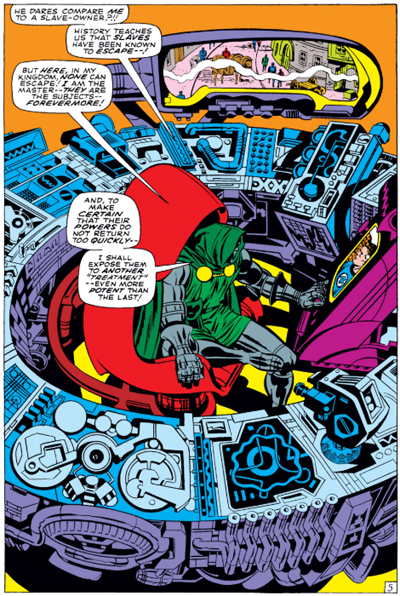 In order to make sure of this he orders the team's food to be drugged so they can be subjected to more of the hypnosis which causes them to be unable to use their powers. This leads to a long sequence focussing on Doom as he orders his subjects around and then sets a trap for some political prisoners, allowing them to think they've escaped so that he can use them as a test for his new killer robots. During this sequence Doom's self-delusion is reinforced, as he talks about his own hatred of violence just after almost throttling someone, and then going to watch prisoners being beaten up on his own instructions.
In order to make sure of this he orders the team's food to be drugged so they can be subjected to more of the hypnosis which causes them to be unable to use their powers. This leads to a long sequence focussing on Doom as he orders his subjects around and then sets a trap for some political prisoners, allowing them to think they've escaped so that he can use them as a test for his new killer robots. During this sequence Doom's self-delusion is reinforced, as he talks about his own hatred of violence just after almost throttling someone, and then going to watch prisoners being beaten up on his own instructions.
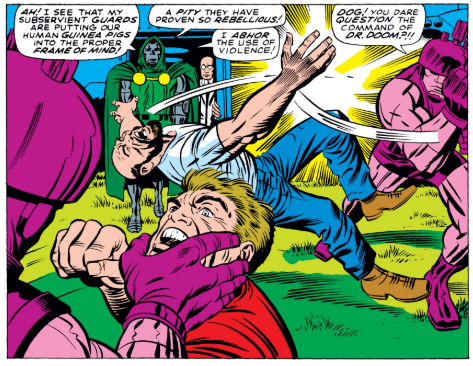 Doom uses such language constantly, not just to trick other people but also when he speaks to himself, showing that it is a worldview that he actually believes in. He is no longer the solo Mad Scientist carrying out his own plans, nor is he the noble revolutionary leading a nation, he is now an avatar for the real-life "supervillains" that Cold War Americans saw ruling Eastern Europe.
Doom uses such language constantly, not just to trick other people but also when he speaks to himself, showing that it is a worldview that he actually believes in. He is no longer the solo Mad Scientist carrying out his own plans, nor is he the noble revolutionary leading a nation, he is now an avatar for the real-life "supervillains" that Cold War Americans saw ruling Eastern Europe.
The escaping prisoners are soon killed by the robots, which leads Doom to herald the next stage of his weapons testing - "the destruction of an entire village." The story then cuts to an image of The Fantastic Four, sitting in the self-same village.
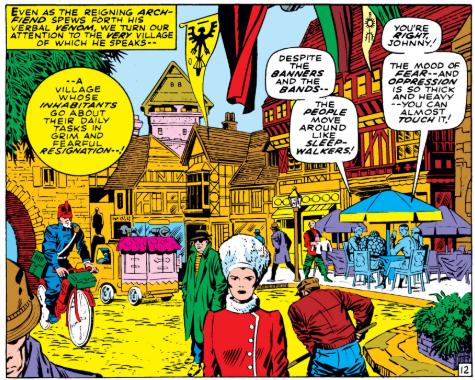 Moving the action to a village, especially an ornate and otherwordly one, draws immediate comparisons with The Prisoner again, set as it was in The Village, shot on location in the ornately designed and otherwordly Portmeirion Village.
Moving the action to a village, especially an ornate and otherwordly one, draws immediate comparisons with The Prisoner again, set as it was in The Village, shot on location in the ornately designed and otherwordly Portmeirion Village.
 The Fantastic Four eat the food supplied for them, and then pass out. This does seem a bit foolish, as it's by no means the first time Doctor Doom has given them drugged food, and this time they wake up to find that they are terrified of anybody even talking about violence.
The Fantastic Four eat the food supplied for them, and then pass out. This does seem a bit foolish, as it's by no means the first time Doctor Doom has given them drugged food, and this time they wake up to find that they are terrified of anybody even talking about violence.
While this is going on Doctor Doom is having his portrait painted. Unusually for him he has demanded that his real face be represented.
 Doom has always been distraught about the destruction of his face, frequently thrown into fits of rage at the injustice of his disfiguration, so it's odd to see that he is now capable of not only looking at himself in the mirror but also appearing without his mask in front of other people. Way back in his origin story he stated that assuming the mask meant an end to Victor von Doom and the beginning of Doctor Doom, so does this mean he is reverting to his previous form? Or is his self-delusion now expanding to the point where he could one day convince himself that he is not ugly?
Doom has always been distraught about the destruction of his face, frequently thrown into fits of rage at the injustice of his disfiguration, so it's odd to see that he is now capable of not only looking at himself in the mirror but also appearing without his mask in front of other people. Way back in his origin story he stated that assuming the mask meant an end to Victor von Doom and the beginning of Doctor Doom, so does this mean he is reverting to his previous form? Or is his self-delusion now expanding to the point where he could one day convince himself that he is not ugly?
He's not there yet though - when an underling expresses the wish that Doom should like his painting, he is swiftly told not to be such an idiot.
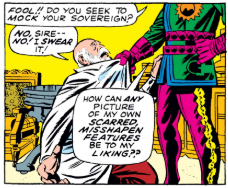 The sitting is interrupted by another Skype call, this time from some Standard Robots calling to tell him that the new Killer Robots have escaped and are heading towards The Village...sorry, towards the village, where a helpless Fantastic Four await.
It's not clear whether they've really escaped, or whether it's all part of Doom's masterplan, because this is where the comic ends, on a classic cliffhanger.
The sitting is interrupted by another Skype call, this time from some Standard Robots calling to tell him that the new Killer Robots have escaped and are heading towards The Village...sorry, towards the village, where a helpless Fantastic Four await.
It's not clear whether they've really escaped, or whether it's all part of Doom's masterplan, because this is where the comic ends, on a classic cliffhanger.
The end of Lee and Kirby's run is often spoken of as a decline from their much-lauded middle-period, but I must say that so far this storyline has been terrific, in terms of plotting, characterisation, and fantastic imagery. It also marks a major turning point in the character development of Doctor Doom, which hopefully will continue as the story progresses!
posted 8/8/2018 by MJ Hibbett
(click here for permanent link)
(0) comments
The Name Is Doom!
It's been a whole year since Doctor Doom last starred in a Marvel comic, and a full two years since the climax of The Peril And The Power, but I think it was worth the wait! Not only is this a great late-period Lee and Kirby story, full of big ideas and amazing artwork, but it also marks a huge shift in Doom's overall character, moving him definitively from his origins as a mad scientist who more or less worked alone to the dictator in charge of a whole country's worth of mad science that he would remain as into the seventies and eighties.
This change in Doom can be seen from the front cover, where he lurks menacingly above the Fantastic Four, who are trapped in the weird world of Latveria. The four-part story which starts in this issue was later acknowledged by Lee and by Kirby as a homage to "The Prisoner", the Patrick McGoohan series based in "The Village" which was first broadcast in the US around the time that Kirby would have been plotting out these issues. He would later go on to pencil an adaptation of the series in 1976 which would not be released until after his death.
It's a little while before we get to Latveria though, as the first few pages follow the Fantastic Four on their way home from the previous issue's storyline with the Inhumans. At the end of the third page the story moves to "a forbidding castle, deep in the heart of the distant Balkans" where an old man is trying to escape a terrifying "him".
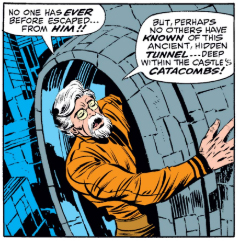 The reader isn't told where this village... sorry, small Balkan state is, or who the man is fleeing (although they could probably guess from the cover), which makes the next page reveal even more powerful than it otherwise would have been. Which is still VERY powerful!
The reader isn't told where this village... sorry, small Balkan state is, or who the man is fleeing (although they could probably guess from the cover), which makes the next page reveal even more powerful than it otherwise would have been. Which is still VERY powerful!
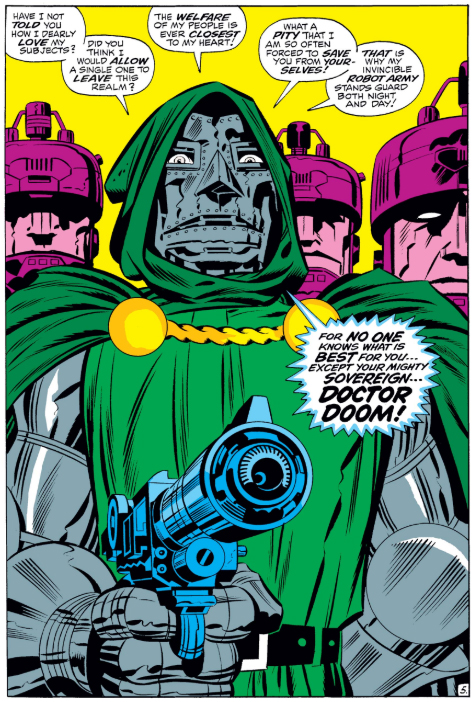 Doom has always been self-deluded, but this character trait is really cranked up here, as he bemoans the fact that some of his citizens are ungrateful for all he does for them - he provides clothes and food and all he asks in return is total obedience. Previously he's either derided his citizens or acted protectively towards them, but now he moves into full-blown dictator mode, acting as a representative of an American view of life in Soviet Russia. This is a brutal tyrant, who tells his people that they are blessed by is rule, and to be happy or die - he is basically Stalin.
Doom has always been self-deluded, but this character trait is really cranked up here, as he bemoans the fact that some of his citizens are ungrateful for all he does for them - he provides clothes and food and all he asks in return is total obedience. Previously he's either derided his citizens or acted protectively towards them, but now he moves into full-blown dictator mode, acting as a representative of an American view of life in Soviet Russia. This is a brutal tyrant, who tells his people that they are blessed by is rule, and to be happy or die - he is basically Stalin.
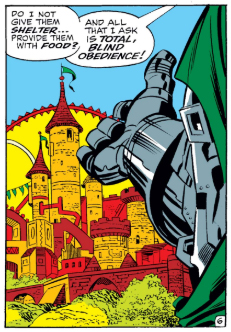 Meanwhile the Fantastic Four are getting a briefing from Nick Fury, who has found a Robot Arm that is so deadly that it takes the combined might of the Fantastic Four and Shield to bring it back under control when it escapes from containment. Fury suspects that this must be the work of Doctor Doom and, fearing the development of terrifying new super-weapons, he asks the Fantastic Four to investigate.
Meanwhile the Fantastic Four are getting a briefing from Nick Fury, who has found a Robot Arm that is so deadly that it takes the combined might of the Fantastic Four and Shield to bring it back under control when it escapes from containment. Fury suspects that this must be the work of Doctor Doom and, fearing the development of terrifying new super-weapons, he asks the Fantastic Four to investigate.
The idea that Doom is harbouring weapons of mass destruction is one that will be returned to many times over the coming years, with any attempt to take action against him often thwarted by the politics of his position as a national ruler. Sometimes Doom will be seen as a representative of the Soviet State, other times a hard to swallow alternative, but here is shown as being even worse than America's sworn enemies. When the Fantastic Four travel incognito through "the heart of Communist-occupied Central Europe" they find that even KGB Agents fear Latveria.
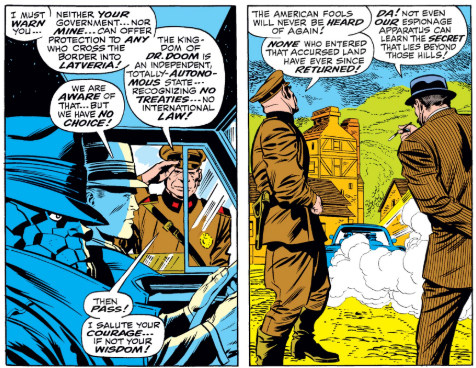 As soon as they enter the country the team (with Crystal doing maternity cover for Sue, who's just had a baby) are attacked by Killer Robots. Reed Richards claims to have had a plan to "let" the Robots capture them, though given the trouble they had fighting a single hand I imagine they'd have struggled to do anything else when there's at least six whole ones attacking.
As soon as they enter the country the team (with Crystal doing maternity cover for Sue, who's just had a baby) are attacked by Killer Robots. Reed Richards claims to have had a plan to "let" the Robots capture them, though given the trouble they had fighting a single hand I imagine they'd have struggled to do anything else when there's at least six whole ones attacking.
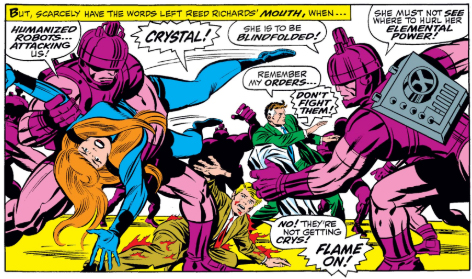 Unfortunately for Reed's "plan" Johnny loses his temper, so the team have to fight anyway, and end up losing. When their defeat is complete Doom himself appears, ordering the robots to take them away as his prisoners.
Unfortunately for Reed's "plan" Johnny loses his temper, so the team have to fight anyway, and end up losing. When their defeat is complete Doom himself appears, ordering the robots to take them away as his prisoners.
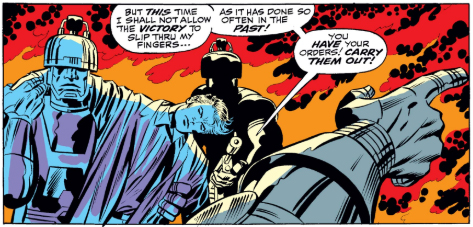 When the team wake up they find themselves in a surreal world, treated as revered guests in a distinctly odd version of Latveria. Previously the country had been an American's idea of what Eastern Europe might be like, based as much on old movies and Kirby's experience of Europe during the Second World War as reality, but here it is deliberately strange, in obvious homage to "The Prisoner". Rather than the dungeons they might have expected, the find themselves in the midst of a parade to welcome them.
When the team wake up they find themselves in a surreal world, treated as revered guests in a distinctly odd version of Latveria. Previously the country had been an American's idea of what Eastern Europe might be like, based as much on old movies and Kirby's experience of Europe during the Second World War as reality, but here it is deliberately strange, in obvious homage to "The Prisoner". Rather than the dungeons they might have expected, the find themselves in the midst of a parade to welcome them.
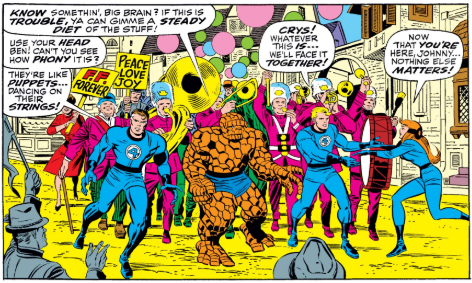 This is, of course, all part of Doctor Doom's plan. However much things change, Doom will always have a plan, and he will always watch it unfold via television.
This is, of course, all part of Doctor Doom's plan. However much things change, Doom will always have a plan, and he will always watch it unfold via television.
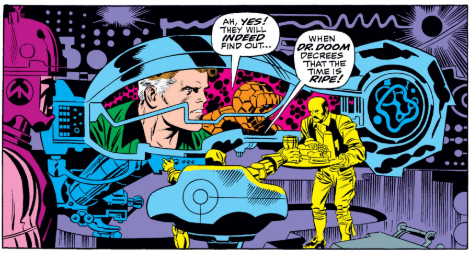 There's just time for Doom to threaten an underling with "the penalty for looking discontented" before the story ends with him appearing on another TV screen to tell the Fantastic Four to be happy... or die!
There's just time for Doom to threaten an underling with "the penalty for looking discontented" before the story ends with him appearing on another TV screen to tell the Fantastic Four to be happy... or die!
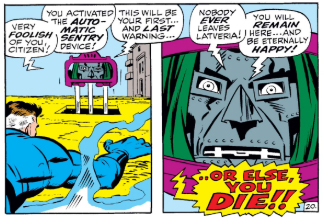 The ever-watchfulness of Doom ties in neatly with the homage to "The Prisoner", but what I think is really interesting here is his development from someone forever leaping out of windows to escape, just a few years ago, to a fully-fledged dictator, ruling an entire nation with maniacal zeal. There's a lot more of this to come!
The ever-watchfulness of Doom ties in neatly with the homage to "The Prisoner", but what I think is really interesting here is his development from someone forever leaping out of windows to escape, just a few years ago, to a fully-fledged dictator, ruling an entire nation with maniacal zeal. There's a lot more of this to come!
posted 1/8/2018 by MJ Hibbett
(click here for permanent link)
(0) comments